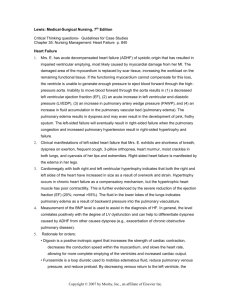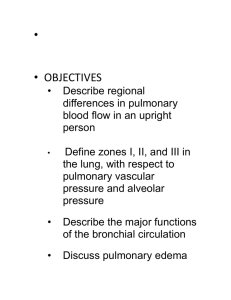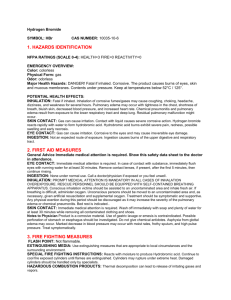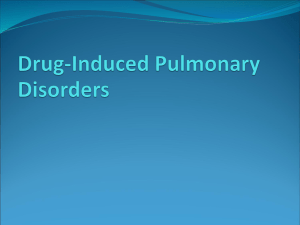Acute pulmonary edema
advertisement
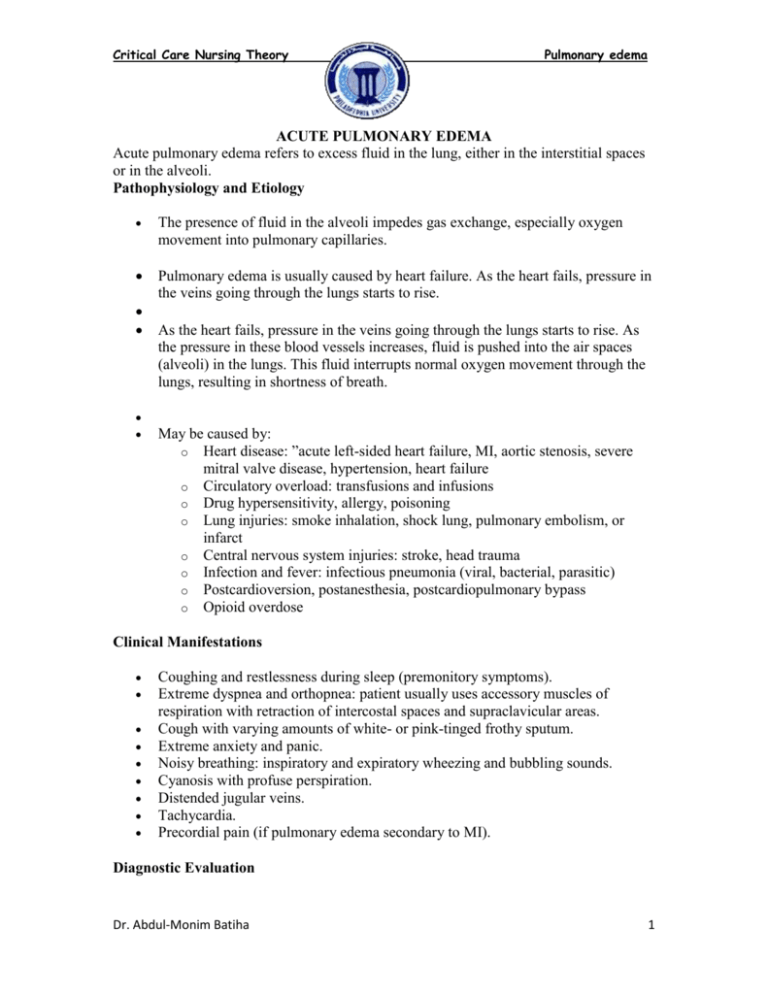
Critical Care Nursing Theory Pulmonary edema ACUTE PULMONARY EDEMA Acute pulmonary edema refers to excess fluid in the lung, either in the interstitial spaces or in the alveoli. Pathophysiology and Etiology The presence of fluid in the alveoli impedes gas exchange, especially oxygen movement into pulmonary capillaries. Pulmonary edema is usually caused by heart failure. As the heart fails, pressure in the veins going through the lungs starts to rise. As the heart fails, pressure in the veins going through the lungs starts to rise. As the pressure in these blood vessels increases, fluid is pushed into the air spaces (alveoli) in the lungs. This fluid interrupts normal oxygen movement through the lungs, resulting in shortness of breath. May be caused by: o Heart disease: ”acute left-sided heart failure, MI, aortic stenosis, severe mitral valve disease, hypertension, heart failure o Circulatory overload: transfusions and infusions o Drug hypersensitivity, allergy, poisoning o Lung injuries: smoke inhalation, shock lung, pulmonary embolism, or infarct o Central nervous system injuries: stroke, head trauma o Infection and fever: infectious pneumonia (viral, bacterial, parasitic) o Postcardioversion, postanesthesia, postcardiopulmonary bypass o Opioid overdose Clinical Manifestations Coughing and restlessness during sleep (premonitory symptoms). Extreme dyspnea and orthopnea: patient usually uses accessory muscles of respiration with retraction of intercostal spaces and supraclavicular areas. Cough with varying amounts of white- or pink-tinged frothy sputum. Extreme anxiety and panic. Noisy breathing: inspiratory and expiratory wheezing and bubbling sounds. Cyanosis with profuse perspiration. Distended jugular veins. Tachycardia. Precordial pain (if pulmonary edema secondary to MI). Diagnostic Evaluation Dr. Abdul-Monim Batiha 1 Critical Care Nursing Theory Pulmonary edema Chest X-ray: shows interstitial edema Echocardiogram to detect valvular disease Measurement of pulmonary artery wedge pressure by Swan-Ganz catheter (differentiates etiology of pulmonary edema: cardiogenic or altered alveolarcapillary membrane) Blood cultures in suspected infection: may be positive Cardiac markers in suspected MI: may be elevated Arterial blood gas (ABG) analysis: may show hypoxemia and impending respiratory failure Management The immediate objective of treatment is to improve oxygenation and reduce pulmonary congestion. Identification and correction of precipitating factors and underlying conditions are then necessary to prevent recurrence. Increasing oxygen tension (oxygen therapy), reducing fluid volume (diuretics, vasodilators), improving the heart's ability to pump effectively (glycosides, beta agonists), and decreasing anxiety guide therapeutic interventions. Oxygen therapy: high concentrations of oxygen are used to combat hypoxemia. Intubation and ventilatory support may be necessary to improve hypoxemia and prevent hypercarbia. Morphine (Duramorph): reduces anxiety, promotes venous pooling of blood in the periphery, and reduces resistance against which the heart must pump. Vasodilator therapy (nitroglycerin [Tridil] and nitroprusside [Nipride]): reduces the amount of blood returning to the heart and resistance against which the heart must pump. Diuretic therapy (furosemide [Lasix], ethacrynic acid [Edecrin]): reduces blood volume and pulmonary congestion by producing prompt diuresis. Contractility enhancement therapy (digoxin [Lanoxin], dopamine [Intropin], dobutamine [Dobutrex]. o Improves the ability of the heart muscle to pump more effectively, allowing for complete emptying of blood from the ventricle and a subsequent decrease in fluid backing up into the lungs. o Aminophylline may prevent bronchospasm associated with pulmonary congestion. Use with caution because it may also increase heart rate and induce tachydysrhythmias.` Complications Dysrhythmias Respiratory failur Nursing Assessment Dr. Abdul-Monim Batiha 2 Critical Care Nursing Theory Pulmonary edema Be alert to development of a new nonproductive cough. Assess for signs and symptoms of hypoxia: restlessness, confusion, headache. Auscultate lung fields frequently. o Note inspiratory and expiratory wheezes, rhonchi, moist fine crackles appearing initially in lung bases and extending upward. Auscultate for extra heart sounds. o Note presence of third heart sound (may be difficult to hear because of respiratory sounds). Identify precipitating factors that place patient at risk for development of pulmonary edema. NURSING ALERT Acute pulmonary edema is a true medical emergency; it is a life-threatening condition. Act promptly to assess patient and notify health care provider of findings. Nursing Diagnoses Impaired Gas Exchange related to excess fluid in the lungs Anxiety related to sensation of suffocation and fear Nursing Interventions Improving Oxygenation Give oxygen in high concentration: to relieve hypoxia and dyspnea. Take steps to reduce venous return to the heart. o Place patient in upright position; head and shoulders up, feet and legs hanging down: to favor pooling of blood in dependent portions of body by gravitational forces; to decrease venous return. Give morphine in small, titrated intermittent doses (I.V.) as directed. o Morphine usually is not given if pulmonary edema is caused by stroke or occurs with chronic pulmonary disease or cardiogenic shock. o Watch for excessive respiratory depression. o Monitor BP because morphine may intensify hypotension. o Have morphine antagonist available: naloxone (Narcan). Give I.V. injections of diuretic. o Insert an indwelling catheter: large urinary volume will accumulate rapidly. o Watch for falling BP, increasing heart rate, and decreasing urinary output: Indications that the total circulation is not tolerating diuresis and that hypovolemia may develop. o Check electrolyte levels because potassium loss may be significant. o Watch for signs of urinary obstruction in men with prostatic hyperplasia. Administer vasodilator if patient fails to respond to therapy. o Monitor by measuring pulmonary artery pressure and CO. Administer aminophylline (Amoline) if ordered. o Monitor blood levels of drug. Dr. Abdul-Monim Batiha 3 Critical Care Nursing Theory Pulmonary edema o Evaluate for adverse effects of drug: ventricular dysrhythmias, hypotension, headache. Administer cardiac glycosides as ordered. Assist with cardioversion if indicated (pulmonary edema may precipitate tachycardias). Give appropriate drugs for severe, sustained hypertension. Continually evaluate the patient's response to therapy. Reevaluate lung fields and cardiac status Decreasing Anxiety Stay with patient and display a confident attitude: the presence of another person is therapeutic, because the acute anxiety of the patient may tend to intensify the severity of patient's condition. (Arterial vasoconstriction diminishes as anxiety is relieved.) Explain to patient in a calm manner all therapies administered and the reason for their use. Explain to patient importance of wearing oxygen mask. Assure patient that mask will not increase sensation of suffocation. Inform patient and family of progress toward resolution of pulmonary edema. Allow time for patient and family to voice concerns and fears. Patient Education and Health Maintenance During convalescence, instruct patient as follows to prevent recurrences of pulmonary edema: Remind patient of early symptoms before onset of acute pulmonary edema; these should be reported promptly. If coughing develops (a wet cough), sit with legs dangling over side of bed. Evaluation: Expected Outcomes Unlabored respirations at 14 to 18 times per minute, lungs clear on auscultation Appears calm; rests comfortably Dr. Abdul-Monim Batiha 4



